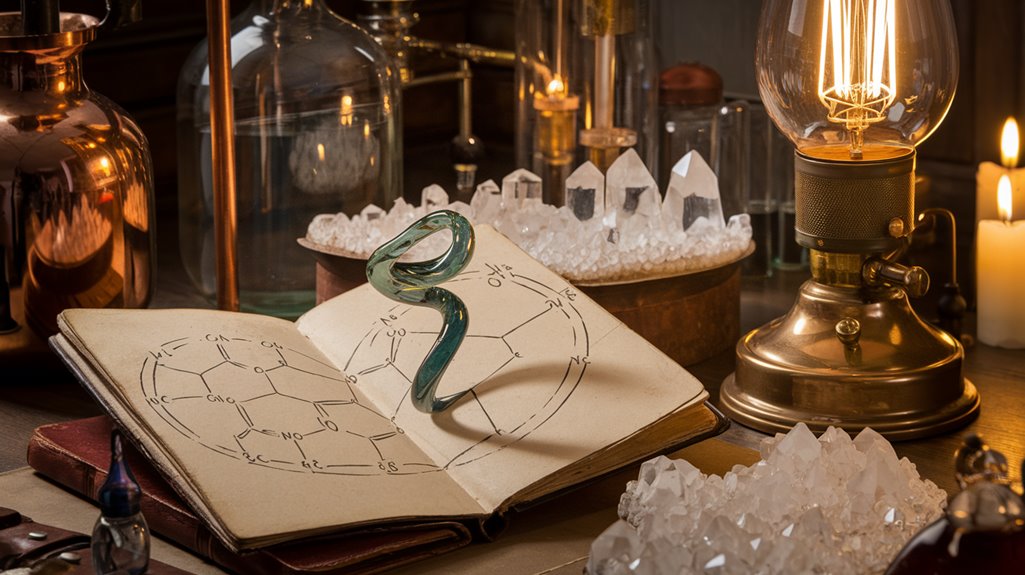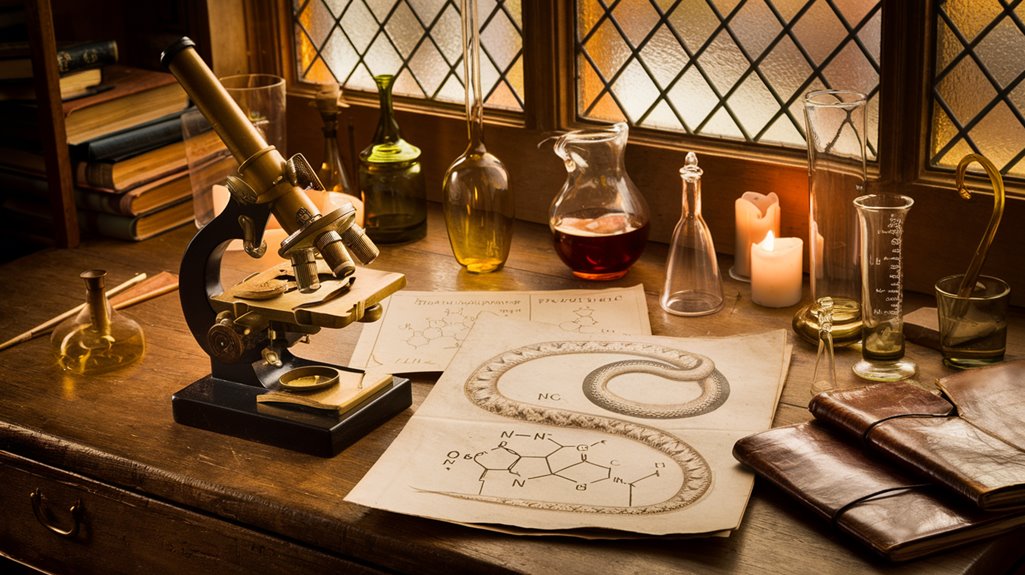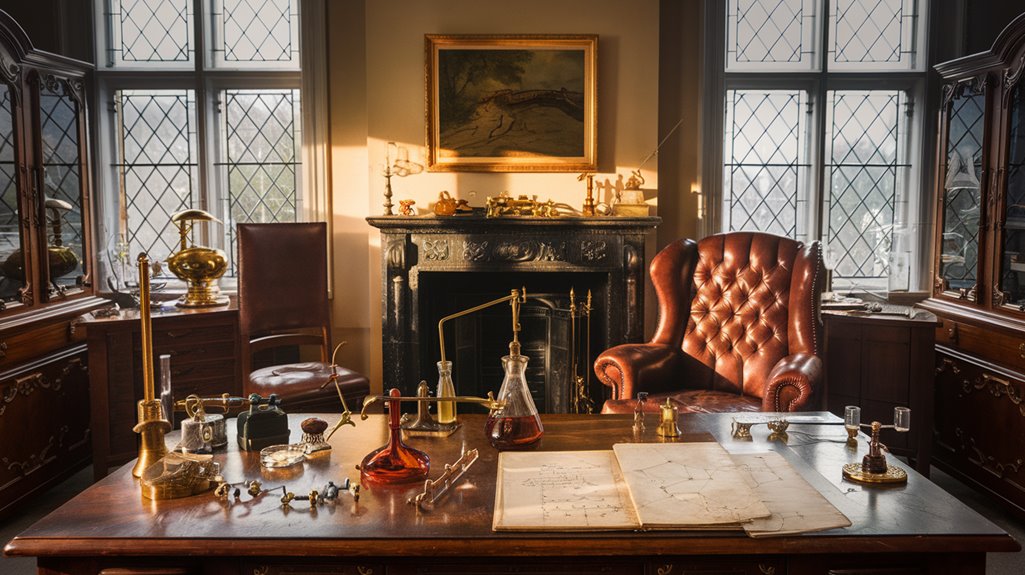He Dreamed a Snake and Solved Chemistry’s Biggest Puzzle
Picture a serpent coiling into a perfect circle, biting its own tail in an endless loop. You've just glimpsed the same vision that jolted August Kekulé awake in 1865 and led him to crack one of chemistry's most perplexing riddles. The story of how a dream about a snake revealed benzene's mysterious ring structure isn't just about scientific discovery—it's about the curious ways your mind can connect dots you didn't even know existed.
The Mystery of Benzene's Structure

While many chemical compounds were well understood by the mid-1800s, benzene presented scientists with a unique puzzle. You might wonder why this simple molecule with equal parts carbon and hydrogen caused such confusion. The answer lies in its unusual chemical stability and behavior, which didn't match any known molecular structures of the time.
When Michael Faraday first isolated benzene in 1825, he found its properties puzzling. Though he determined its basic composition, the molecule's structure remained elusive. Faraday named it bicarburet of hydrogen and discovered it had a boiling point of 80°C.
Scientists proposed various models, but none could explain benzene's remarkable stability or its resistance to typical chemical reactions. Early chemists found it useful as a universal organic solvent, making it valuable for laboratory work despite its mysterious structure. The molecule's unique characteristics suggested something revolutionary about its structure – a mystery that would challenge chemists for decades until Kekulé's groundbreaking ring structure proposal in 1865.
A Snake-Inspired Vision
Nature's ingenuity often inspires scientific breakthroughs, as demonstrated by pit vipers whose remarkable heat-sensing abilities have led to new insights in materials science.
You'll find that snake anatomy, particularly the pit organ near their nostrils, contains a specialized membrane that converts heat into electrical signals, allowing them to detect prey in complete darkness within 40 centimeters. The pit organs are hollow chambers measuring between 10 to 15 millimeters in thickness.
The University of Houston's research team has revealed this mystery by developing a mathematical model explaining heat detection in soft materials.
They've discovered that by embedding stable charges into flexible structures, you can create pyroelectric materials that convert heat to electricity.
This breakthrough could revolutionize how we develop thermoelectric transducers, moving away from rigid crystals toward soft, flexible materials – all inspired by a snake's remarkable sensory abilities.
The research was published in Matter and encourages collaboration among scientists to further investigate the mechanisms of snake infrared sensing.
Breaking New Ground in Chemistry
Recent breakthroughs in chemistry have revolutionized our understanding of molecular engineering and synthesis. You'll find that researchers are revealing synthetic pathways that were once thought impossible, like the University of Minnesota's creation of a reactive compound that eluded scientists for over 120 years.
These molecular innovations aren't just laboratory curiosities. They're opening doors to better drug treatments, safer agricultural products, and advanced electronics. The groundbreaking research focuses on N-heteroarenes, which are essential components in pharmaceuticals and pesticides. Scientists have made a major breakthrough by synthesizing a novel hexazine compound under extreme pressure and temperature conditions.
You're seeing this impact through discoveries like the SNV reaction, which offers new ways to construct complex molecules with precise structures. Scientists are also making strides in environmental chemistry, developing waterproof surfaces and finding novel methods to reduce carbon dioxide emissions.
From fighting addiction with engineered antibodies to improving solar energy conversion, chemistry's reach extends into every aspect of modern life.
The Truth Behind the Dream Story
Since the famous 1890 Benzolfest celebration, August Kekulé's tale of a serpentine dream has captivated chemists and historians alike.
You might wonder about the dream's authenticity, as he shared this story 28 years after his groundbreaking benzene structure discovery.
Historical skepticism surrounds Kekulé's account, with some scholars suggesting he may have fabricated the dream to strengthen his priority claim.
After completing his studies in Paris, Kekulé earned his doctorate in 1852 and began developing his theoretical work on molecular structures.
They'll point to Josef Loschmidt's 1861 ring structure proposal and an 1886 parody featuring six monkeys in a circle as potential influences on Kekulé's narrative.
You're looking at a story that's sparked endless debate among historians, who question whether the dream truly inspired his breakthrough or if it's a carefully crafted tale meant to cement his legacy in chemistry's history.
The legend became even more intriguing after Kekulé received von Stradonitz ennoblement from Kaiser Wilhelm II in 1895.
Revolutionizing Organic Chemistry

As breakthroughs in C-H functionalization and quantum tunnelling reshape organic chemistry, you're witnessing a revolution in how scientists manipulate molecules. These techniques have transformed what was once thought impossible into routine laboratory procedures.
You'll find that C-H functionalization allows chemists to convert inactive carbon-hydrogen bonds into functional groups, opening new pathways for drug development and material synthesis. Twenty-five professors nationwide collaborate through the National Science Foundation Center to advance these groundbreaking methods. Photochemical flow reactors have proven crucial for scaling up these innovative processes.
Meanwhile, quantum tunneling enables reactions that were previously considered thermodynamically impossible. These advances, coupled with high-throughput experimentation and machine learning, have accelerated the discovery of new compounds.
The impact extends beyond academic labs. Industry has embraced these innovations, particularly in drug development and polymer production.
With dirhodium catalysts offering unprecedented site selectivity, you're seeing the boundaries of chemical synthesis expand in ways that earlier generations could only dream about.
A Legacy That Shaped Modern Science
The giants of scientific discovery left footprints that still guide modern research and innovation. You can trace the impact of their scientific methodology from Galileo's mathematical approach to nature through Einstein's revolutionary theories that power today's technology.
When you examine their historical significance, you'll find that groundbreaking works like Copernicus's "De revolutionibus" and Newton's "Principia" fundamentally transformed how we perceive our universe. Scientists like Einstein spent decades pursuing a Grand Unified Theory to explain all physical phenomena. The systematic experimentation they pioneered revolutionized how we conduct scientific research.
You're benefiting from these pioneers' legacy every day, from the lasers in your devices to the computer chips that power them. Their contributions weren't just about individual discoveries – they created a framework for modern scientific inquiry.











